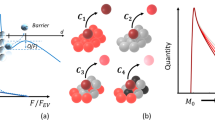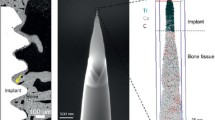Abstract
ELECTRIC-field-induced evaporation of ions from a needle-like surface, and their subsequent identification by time-of-flight mass spectrometry, forms the basis of the atom-probe technique1. This has proved to be a powerful analytical tool2,3, permitting the quantitative determination of material composition in a small selected region of the surface (depths of 1–5 nm) with single-layer resolution. Positional information for the atoms within each layer is lost, however. In contrast, the field-ion microscope3 provides atomic-resolution images of surfaces, but without information about the nature of the atoms. Several attempts have been made to combine these two techniques by extending the time-of-flight measurement into two dimensions, but they have been limited by their inability to identify all chemical species4 or to combine spatial and temporal information for multiple events5, especially for ions with very similar mass-to-charge ratios6. Here we make use of a recently developed7 multiple-impact detector to construct a position-sensitive atom probe with sufficiently high temporal resolution (of the order of 10 ns) to avoid these earlier problems; thus, reliable composition and position data can be obtained at the same time. We illustrate the performance of this instrument by imaging the three-dimensional distribution of chemical heterogeneities in a nickel-based alloy on a near-atomic scale.
Similar content being viewed by others
References
Müller, E. W., Panitz, J. A. & McPane, S. B. Rev. scient. Instrum. 39, 83–86 (1968).
Blavette, D. Surf. Sci. 266, 299–309 (1992).
Miller, M. K. & Smith G. D. W. Atom-Probe Microanalysis: Principle and Applications to Materials Problems (Mat. Res. Soc., Pittsburg PA, 1989).
Panitz, J. A. J. Vac. Sci. Technol. 11 206–210 (1974).
Miller, M. K. Surf. Sci. 266, 494–499)(1992).
Cerezo, A., Godfrey, T. J. & Smith, G. D. W. Rev. scient. Instrum. 59, 862–866 (1988).
Deconihout, B. et al. Appl. Surf. Sci. (in the press).
Blavette, D., Bostel, A. & Sarrau, J. M. J. Phys. 47, 473–478 (1986).
Wijnaendts Van Resandt, R. W., Harink, H. C. & Los, L. J. Phys. E: Scient. Instr. 9 503–509 (1976).
Blavette, D. & Bostel, A. Acta met. 32, 811–816 (1984).
Author information
Authors and Affiliations
Rights and permissions
About this article
Cite this article
Blavette, D., Bostel, A., Sarrau, J. et al. An atom probe for three-dimensional tomography. Nature 363, 432–435 (1993). https://doi.org/10.1038/363432a0
Received:
Accepted:
Issue Date:
DOI: https://doi.org/10.1038/363432a0
- Springer Nature Limited
This article is cited by
-
Effect of Substrate Bed Temperature on Solute Segregation and Mechanical Properties in Ti–6Al–4V Produced by Laser Powder Bed Fusion
Metallurgical and Materials Transactions A (2023)
-
Opportunities of combinatorial thin film materials design for the sustainable development of magnesium-based alloys
Scientific Reports (2021)
-
Probing embedded topological modes in bulk-like GeTe-Sb2Te3 heterostructures
Scientific Reports (2020)
-
Atom Probe Tomographic Imaging of PbS Quantum Dot Formation on Neodymium Clusters in Silicate Glasses
Scientific Reports (2019)
-
Review of the synergies between computational modeling and experimental characterization of materials across length scales
Journal of Materials Science (2016)





